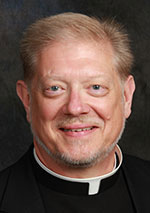That All May Be One / Fr. Rick Ginther
Reflection on Compostela leads to statement on the way to unity
 I recently returned from pilgrimage. Our group visited many Marian Shrines: Fatima, Portugal; Lourdes, France; Barcelona’s Basilica of Mary, Star of the Sea and the monastery of Montserrat, both in Spain.
I recently returned from pilgrimage. Our group visited many Marian Shrines: Fatima, Portugal; Lourdes, France; Barcelona’s Basilica of Mary, Star of the Sea and the monastery of Montserrat, both in Spain.
The time away was a gift from God to us 19 fellow pilgrims. It was a time for reflection, conversion and devotion. (You can catch a glimpse of the experience by visiting Facebook. Search for Richard Ginther, and check out my personal posts from Sept. 18-29).
Our paths as pilgrims crossed that of other millions who have journeyed in like manner.
For me, most significantly, my path repeatedly intersected “The Way,” the “Via Compostela” of St. James.
Most assume that there is but one “Way,” from southern France (Camino Francés). I learned, however, that the “Way” has a variety of routes.
One traces from Lisbon, Portugal, (Camino Portugués), while others originate elsewhere—Camino de Finisterre and Muxia, Camino Aragones, Le Puy Route, Camí de Sant Jaume, Camino de Madrid, Camino Ingles (English Way), Camino Primitivo, Tunnel Route, Via de la Plata, Camino del Salvador and Camino del Norte (Northern Way).
So many ways—longer, shorter, mountainous, flatland, dry, moist, arduous, easier—with a common goal.
As I transected the varied ways to Compostela, I reflected on a Lutheran/Catholic document titled “Declaration on the Way.” In a sense, it is a pilgrims’ statement on the way to unity.
Released in October of 2015, it is “… both an expression of the consensus achieved by Lutherans and Catholics on the central topics of church, ministry and Eucharist and an indication of differences still remaining to be resolved.” (Executive Summary)
The U.S. Conference of Catholic Bishops’ Committee for Ecumenical and Interreligious Affairs and the Evangelical Lutheran Church in America jointly published the document.
Lutherans and Catholics have for 500 years been traveling divergent roads, both seeking salvation in Christ. Today, however, we have begun to see our divergent ways intersecting at a point where we walk together yet separately.
The document has five sections. After the introduction, Section II presents 32 statements of agreement drawn “from the international and regional dialogues of the last 50 years.” It is, as the summary says, “ … a powerful litany of consensus reflect[ing] the real, if still incomplete, common affirmation possible in these crucial … areas.”
Section III “elaborates and documents each of the 32 consensus affirmations which comprise the statement of agreements.”
Section IV speaks to 15 topics “that have arisen in dialogue.” Many are not seen as “church dividing,” and “some ways forward are sketched.” Clearly, here we see the “on the way” character of the declaration.
Section V offers practical, next steps. “It recommends that the LWF [Lutheran World Federation] and the PCPCU [Pontifical Council for Promoting Christian Unity] ‘together receive, affirm and create a process to implement consequences of the 32 statements.’ ” Such a recognition would itself be a “further step on the way to unity.”
Finally, the declaration invites the PCPCU and LWF to “create a process and timetable for addressing the remaining issues.” These could include the expansion of opportunities for Catholics and Lutherans to receive holy Communion together (e.g. couples in a Lutheran/Catholic marriage).
The Second Vatican Council repeatedly employed the image of “the pilgrim Church.” I would hope that reflecting that, the “Declaration on the Way” will become an engine to move us toward fulfilling Jesus’ call: that all may be one.
(Father Rick Ginther is director of the archdiocesan Office of Ecumenism. He is also pastor of Our Lady of Lourdes Parish in Indianapolis.) †
 I recently returned from pilgrimage. Our group visited many Marian Shrines: Fatima, Portugal; Lourdes, France; Barcelona’s Basilica of Mary, Star of the Sea and the monastery of Montserrat, both in Spain.
I recently returned from pilgrimage. Our group visited many Marian Shrines: Fatima, Portugal; Lourdes, France; Barcelona’s Basilica of Mary, Star of the Sea and the monastery of Montserrat, both in Spain.